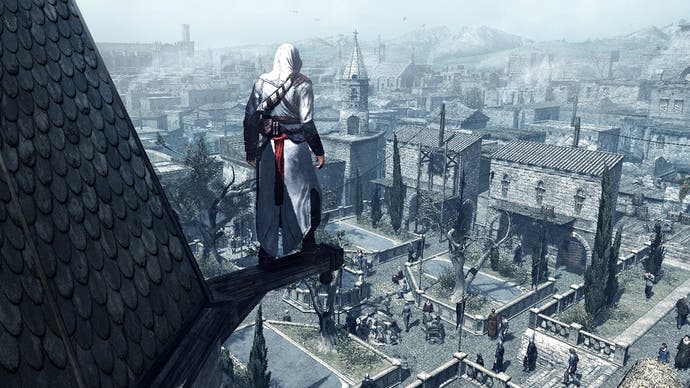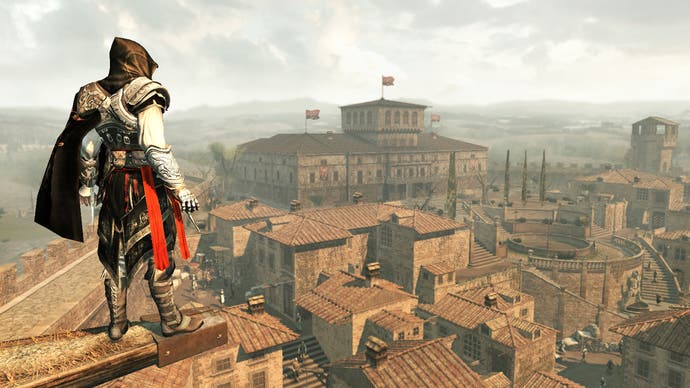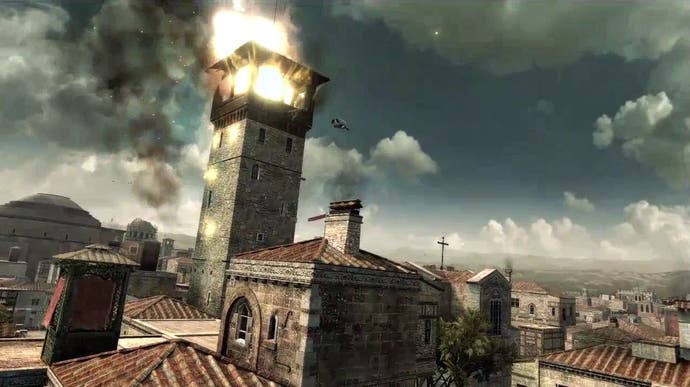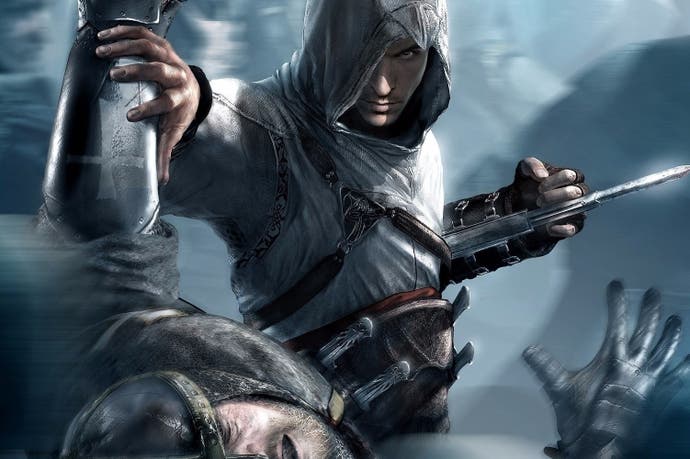Tracing the ancestry of Assassin's Creed, from Prince of Persia to the Holy Land
Assassin's Creed's origins: A chat with Patrice Désilets about building the tower.
If there are moments of serenity in the original Assassin's Creed, which turns 10 years old next month, they are surely to be found in the act of scaling towers - a way of pacing consumption of the landscape that has shaped almost every subsequent open world escapade, from Rocksteady's Batman Arkham games to the mighty Breath of the Wild. The city is a fading murmur beneath you, the cries of beggars and traders and the jingle of guard awareness icons whisked away by the wind. The occasional frustrations of shouldering through mobs or scrambling across uneven rooftops are forgotten. There is nothing but the scuffle of toes on masonry and the rattle of Altair's sword in its sheath.
Reach the top and you can synchronise with the Animus device, the game-within-a-game that serves as Assassin's Creed's frame narrative, exposing nearby landmarks and activities on your minimap. But the real reward for your labours is eagle-diving from the summit, back into that haystack of threats and distractions. You clamber out of the world, you soak up the view, you plunge back in, you move onto the next tower - a digestible, compulsive little design loop that has come to serve on the one hand as a tacit colonial fantasy, the mapping of "exotic" yet highly regularised terrain, and on the other as a kind of stress release valve. Wherever you are in Assassin's Creed or one of its bigger, noisier descendants, there is always a tower of sorts you can climb, a chance to distance yourself from the hubbub in order to take its measure.

Or at least, that's my reading. Assassin's Creed's estranged creator Patrice Désilets remembers the tower mechanic not as a way of creating distance, but fostering closeness. The beauty of that lonely, often-repeated climb, he tells me, is that player and character are both alike driven simply by the urge to see. "When you can actually put players in the same psychological state as the character, you've won, and that's always my goal. You don't always feel this connection between the character and the player, but [in Assassin's Creed] you're actually there in the world, you are Altair, because you are basically thinking the same thing." Much as the architects of the Tower of Babel sought entrance to heaven, so Désilets and his team saw those towers as gateways between reality and representation. It's an intriguing observation not least because it erases the presence of Desmond Miles, the original Assassin's Creed trilogy's much-despised modern-day protagonist, who is technically "controlling" his ancestor Altair on your behalf via the Animus.
Once one of Ubisoft Montreal's leading designers before a dramatic parting of the ways in 2010, Désilets has been fascinated by the threshold between player and avatar throughout his career. He came to fame as director of Prince of Persia: Sands of Time, the tale of a vast, tumbledown palace infested by sand demons that is told in retrospect by its own leading man, allowing the writers to explain away player deaths as the character literally forgetting himself. The Animus, a piece of VR hardware that allows the user to relive memories passed down through DNA, elaborates on this, with the threat of "desynchronisation" between your actions and Altair's memories replacing the Prince's rueful line, "no, that's not how it happened".
Ironically enough, much of this conceptual evolution has become apparent to Désilets only in hindsight. "As an employee, you've just finished a game, you go on vacation, you come back and you have to start a new one," he explains. "So you start with what you had the month before, and your brain is still wired to do a Prince of Persia game. So you look at what you had a month ago, and some things you keep and some things you redo, and the Animus was just the device that replaced the Prince talking to Farah. It's been 10 years now, so I can analyse this, but when you're making it you don't think, you just do."

The Animus isn't the only component of Assassin's Creed that emerged from the Sands of Time - much of the game consists of resurrected concepts that weren't possible on the previous generation of console hardware. "We received a mandate as soon as we finished Prince of Persia to try to redefine the action-adventure genre on the next generation - this is January 2004. And we didn't know what the next gen would be at the time, we didn't know about the Xbox 360 and the PS3.
"So we said 'Oh, we'll have so much power that everything we wanted to do in Sands of Time, we'll be able to do this time around, and I remember that one thing I wanted was to have people in the palace. We couldn't put all those NPCs on screen, so we eventually got rid of them entirely and kept only the enemies. That was something I wanted from the start, to have a game world with a lot of NPCs. And then, since I'd just finished a Prince of Persia game, I had a hard time doing another game with a prince - an action game character who's waiting to take the place of his dad, which is basically what a prince is. And so you combine a crowd and a more action-oriented character, and you come up with an assassin in a city. That's basically the genesis of Assassin's Creed."
Unveiled at E3 2006 to rapturous reaction, the game proved a huge success, distinguished from rivals like Crackdown by the fidelity and liveliness of its 12th century cities and the superhuman fluidity of its parkour moveset, which built on the already sterling animations of Sands of Time. Even today, many of its achievements are breathtaking. At a time when most platformers obliged you to think through every single leap, here was a specimen happy to gloss over the fine details, allowing you to swarm acrobatically across the architecture for as long as you kept the trigger held. Assassin's Creed also introduced the concept of social stealth to open world games, with players engulfed by a shifting crowd who serve as both camouflage and a low-level surveillance system.
Its spartan selection of activities disappointed many, however, and the notion of manipulating a simulation within a simulation proved divisive - partly thanks to Desmond's ditchwater-dull personality, and partly because the idea of having to justify widely accepted design elements like heads-up displays with reference to a narrative McGuffin struck some players as bizarre. Where Sands of Time's frame narrative was elegant and poignant, gracefully accounting for your agency within the game's rigid scheme, the Animus often felt like the answer to a question nobody had asked.

Eurogamer's 7/10 review caused a stir back in 2007, but a decade on, Désilets is happy to concede that the original Assassin's Creed was an acquired taste. "After four years in the cycle, we decided to just ship it - let's ship something that will establish the franchise, like you said. Let's ship the toy, basically. It's like football for you in the UK, the ball is a toy you can play a bunch of games with, and the most popular is football. AC1 is the toy, it's the way this character moves in the world, how he fights and some of the mechanics, but a lot of the things we did in the second one were already planned on paper and designed for the first."
Set a few hundred years later in Renaissance Italy, Assassin's Creed 2 offered a larger and more diverting set of activities and systems than its predecessor, albeit pegged down once again by those synchronisation towers. Players could now own property, buy and customise outfits and hire courtesans, thugs or thieves to help out with a hit. While the game retained Desmond as present-day proxy in addition to the Animus construct, it opted for a younger, less experienced ancestor protagonist, babyfaced heartthrob Ezio, who could mirror the player's increasing competence. "Altair was a master assassin - he's already maxed out his RPG level if you will, so it was really tough to teach you to play this character. With the second game, with Ezio - Ezio is like you. He's learning to become an Assassin, so it was easier to create a game around that. Altair was the perfect character to play as a toy, because the character could do a lot from the start, and Ezio was the perfect character to build up a game around, learning how to play alongside you."
Now Ubisoft's flagship franchise, Assassin's Creed attracted imitators within the company. To pick the most obvious example, Far Cry 3's radio masts serve much the same purpose as synchronisation viewpoints, breaking down a large world into a series of varied platforming puzzles that slowly peel away the fog of war. "As a group, as a corporation we did share knowledge, you had to," acknowledges Désilets. "But during the day-to-day? Never. I remember we were in the basement, so you didn't come across anyone even in the elevator. And personally, it's sometimes tough for people who work with me because I become almost autistic in my way - I'm making a parallel universe and want to make sure that universe is fun to play with, so I'm there in the office but at the same time I'm in Jerusalem a billion years ago."
Ideas circulated between teams and studios under the careful eye of Ubisoft's legendary editor's group, a Templar-esque inner circle of senior staff. "They were the ones touching all of the projects," says Désilets. "They were telling you stuff, and I guess they were stealing some of the cool ideas from different projects and saying, well, here at Ubi this it's how it's supposed to work, and this is how we want games to be, this is what a good game is." Together with the sheer pace of Assassin's Creed launches - one major title a year from 2009 to 2015, a frequency matched only by Call of Duty - this overarching direction has bred a certain conservatism. "I guess some of the other titles at Ubi, and I'm not being judgemental here, but I guess, from an outside view they all look the same. The mechanics are maybe too close to each other. Oh, it's a Ubisoft game, so there will be a tower..."
Weary of the politics and pressures of leading what had become one of the industry's most profitable licences, Désilets left Ubisoft midway through Assassin's Creed: Brotherhood's development in 2010. After a short absence from development, he joined THQ Montreal to work on a game codenamed Underdog and a new historical open world project, 1666. Ubisoft, however, acquired THQ Montreal during a sale of assets following THQ's bankruptcy across 2012 and 2013. It was not a joyful reunion: less than two months after returning to the company, Désilets was abruptly fired and escorted from the building. There followed an agonising legal struggle for control of the 1666 IP, which Ubisoft eventually washed its hands of in 2016.
Désilets is philosophical about the experience in hindsight, but remains cool on his former employer. "It's been seven years - in some belief systems, they say that's a full life cycle, so right now I'm totally... neutral." Famously, he has yet to play an Assassin's Creed game all the way through since leaving the company - the experience is too stressful, and in any case, Désilets has other towers to climb in the shape of Ancestors: The Humankind Odyssey, a mysterious new open world in development at his start-up studio Panache Digital Games.
"I have no emotion towards what they're doing, but I will never buy one of their games," he says. "It's a rule in my family. You can't see me but I'm smiling. It's a joke and it's not a joke. It's OK, I don't really care, I had a hard time, we've made our peace, it's all good, but I'm elsewhere right now and good luck to them, and I know people like what they're doing, but it's not my cup of tea. Because it's been rough, I was alone against a multi-national corporation. And it was not healthy for a while, but now it is and I don't care, and I have my own studio, and we're having fun. That's what's important."


